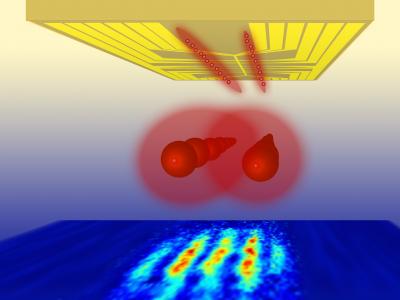The transition to thermal equilibrium in the quantum world has been found to be more complicated than what has been assumed. When ice cubes are put in hot water they will not remain stable, but will melt to reach thermal equilibrium in the normal state.
 On an atom chip (top), clouds of ultracold atoms (red) are created. They are allowed to interfere, creating an ordered matter-wave interference pattern (bottom). Credit: Vienna University of Technology
On an atom chip (top), clouds of ultracold atoms (red) are created. They are allowed to interfere, creating an ordered matter-wave interference pattern (bottom). Credit: Vienna University of Technology
During melting, a quasi-stationary intermediate state, considered as a "pre-thermalization" phenomenon may exist between the initial and final states. In quantum physics, this phenomenon may play an important role in non-equilibrium processes.
Jörg Schmiedmayer, a professor at the Vienna University of Technology, stated that a Bose-Einstein condensate, which is a one-dimensional quantum gas of ultracold atoms, was used in their study. Researchers at the Vienna University of Technology’s Center for Micro- and Nanostructures created a unique atom chip for this study. The atomchip was used to split this condensate rapidly into two. If they were rejoined immediately an ordered matter-wave interference pattern was formed. If a delay was allowed, then the interference pattern order decayed. Initially it decayed rapidly and then it stayed in an intermediate pre-thermalized state. A disorder has been observed in this state which is attributed to the split of the atom cloud based upon the laws of quantum physics.
In quantum physics, the transition to thermal equilibrium plays an important role. Non-equilibrium states that occur in quantum computers when data is stored lose the quantum state due to the tendency to reach thermal equilibrium.
After the Big Bang occurred, matter in the universe was considered to be in a quark-gluon plasma non-equilibrium state, for fractions of a second. Some parts of quark-gluon plasma move towards thermal equilibrium more rapidly. This is considered to be due to "pre-thermalization."
The study of atom clouds may aid in gaining more knowledge about non-equilibrium processes.